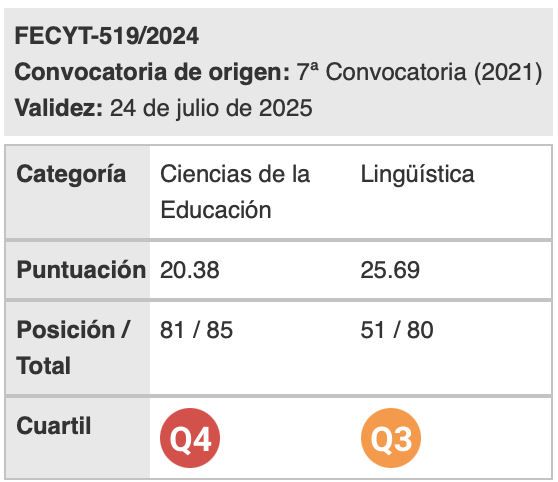Uso de las nuevas tecnologías en la enseñanza de lenguas extranjeras
Palabras clave:
on-line teaching, technology, computer-mediated communication, computer toolsResumen
This paper looks at the ever-growing influence of new technologies on the process of teaching and learning foreign languages. An analysis is made of the main tools currently used by language teachers, both general tools, such as blogs and wikis, and tools designed specifically for teaching. There is also a study of the most important authoring systems, on the one hand, and of the computer applications used to create interactive materials for didactic purposes, on the other. The paper then scans academic articles published in journals and comments on the results achieved with the use of those tools. These results are, in most cases, highly positive. Finally, there is a review of published studies dealing with so-called computer-mediated communication, focusing on the effect it has on the process of learning a foreign language.
Descargas
Citas
Abdous, M., Camarena, M. M. y Facer, B. R. (2009). MAll Technology: Use of Academic Podcasting in the Foreign language Classroom. ReCALL, 21(1), 76-95. doi:10.1017/S0958344009000020
Adell, J. (2007). Wikis en educación. En J. Cabero y J. Barroso (Eds.), Posibilida- des de la teleformación en el Espacio Europeo de Educación Superior (pp. 323-333). Granada: Editorial Octaedro Andalucía.
Allum, P. (2002). CAll and the classroom: the case for comparative research. ReCALL 14(1), 146-166. doi: 10.1017/S0958344002001210
Arslan, R. Ş. y Şahin-Kizil, A. (2010). How can the use of blog software facili- tate the writing process of English language learners? Computer Assisted Lan- guage Learning, 23(3), 183-197. doi:10.1080/09588221.2010.486575
Austin, R. y Mendlick, F. (1993). E-mail in modern language development. ReCALL, 5(9), 19-23. doi:10.1017/S0958344000004079
Barr, D., Leakey, J. y Ranchoux, A. (2005). Told like it is! An Evaluation of an integrated Oral development Pilot Project. Language Learning & Techno- logy, 9(3), 55-78. Recuperado 30 de mayo de 2011, de http://llt.msu.edu/ vol9num3/barr/
Blake, R., Wilson, N. L., Cetto, M. y Pardo-Ballester, C. (2008). Measuring Oral Proficiency in distance, Face-to-Face, and Blended Classrooms. Langua- ge Learning & Technology, 12(3), 114-127. Recuperado 30 de mayo de 2011, de http://llt.msu.edu/vol12num3/blakeetal/
Bower, J. y Kawaguchi, S. (2011). Negotiation of Meaning and Corrective Feedback in Japanese/English eTandem. Language Learning & Technology, 15(1), 41-71. Recuperado 3 de julio de 2011, de http://llt.msu.edu/issues/ february2011/bowerkawaguchi.pdf
Bradley, L., Lindström, B. y Rystedt, H. (2010). Rationalities of collabora- tion for language learning in a wiki. ReCALL, 22(2), 247-265. doi:10.1017/ S0958344010000108
Bray, E. (2010). Using Videomail (Vmail) Effectively in Online intercultural Exchanges. CALL-EJ Online, 11(2). Recuperado 29 de mayo de 2011, de http://callej.org/journal/11-2/bray.html
Cain, R. (2008). Podcasting for Beginners. TESOL-Spain Newsletter 31(3), 10-12.
Campbell, A. P. (2003). Weblogs for use with ESl classes. The Internet TESL Journal, 9(2). Recuperado 17 de mayo de 2011, de http://iteslj.org/Techni- ques/Campbell-Weblogs.html
Carracedo, L. N. (2009). El blog en clase de lengua extranjera [Resumen] [Ver- sión electrónica]. Revista Digilenguas, 2, 43.
Castrillo Larreta, M. D. (2004). E-learning en la enseñanza de lenguas moder- nas: estudio empírico basado en el curso virtual de alemán para hispanohablantes Prima@. Cibernetia, tesis doctorales, enseñanza de lenguas, 1.
Cataldo, S., Lamberti, A. y Martínez Vázquez, J. (2009). El uso de blogs en los procesos de enseñanza-aprendizaje de ElE [Resumen] [Versión electró-nica]. Revista Digilenguas, 2, 55.
Chapelle, C. A. (2001). Computer Applications in Second Language Acquisition. Foun-
dations for Teaching, Testing and Research. Cambridge: Cambridge University Press.
Chen, J., Belkada, S. y Okamoto, T. (2004). How a Web-based Course Facili- tates Acquisition of English for Academic Purposes. Language Learning & Technology 8(2), 33-49. Recuperado 28 de mayo de 2011, de http://llt.msu.edu/ vol8num2/chen/
Clark, R. E. (1994). Media and method. Educational Technology Research and Devel- opment, 42(3), 7-10. doi: 10.1007/BF02298090
Comisión Europea (2007). Libro verde. El Espacio Europeo de Investigación: nuevas perspectivas [Versión electrónica]. Bruselas: Autor.
Coniam, D. (2008). Evaluating the language resources of chatbots for their potential in English as a second language. ReCALL, 20(1), 98-116. doi:10.1017/ S0958344008000815
Ellis, R. (2003). Task-based language learning and teaching. Oxford: Oxford Univer- sity Press.
Elola, I. y Oskoz, A. (2010). Collaborative Writing: Fostering Foreign language and Writing Conventions development. Language Learning & Technology, 14(3), 51-71. Recuperado 29 de mayo de 2011, de http://llt.msu.edu/vol14num3/ elolaoskoz.pdf
González-Bueno, M. (1998). The effects of electronic mail on Spanish l2 dis- course. Language Learning and Technology, 1(2), 55-70. Recuperado 28 de mayo de 2011, de http://llt.msu.edu/vol1num2/article3/
Greenfield, R. (2003). Collaborative e-mail exchange for teaching secondary ESl: A case study in Hong Kong. Language Learning & Technology, 7(1), 46-70. Recuperado 18 de febrero de 2010, de http://llt.msu.edu/vol7num1/green- field/
Hampel, R. y Hauck, M. (2004). Towards an effective use of audio conferenc- ing in distance language courses. Language Learning & Technology, 8(1), 66-82. Recuperado 19 de marzo de 2010, de http://llt.msu.edu/vol8num1/ham- pel/
Hao-Jan Chen, H. (2011). developing and evaluating an oral skills training website supported by automatic speech recognition technology. ReCALL, 23(1), 59-78. doi:10.1017/S0958344010000285
Heins, B., Duensing, A., Stickler, U. y Batstone, C. (2007). Spoken interac- tion in online and face-to-face language tutorials. Computer Assisted Language Learning, 20(3), 279-295. doi: 10.1080/09588220701489440
Hubbard, P. (Ed.) (2009). Computer Assisted Language Learning, Volume 1: Founda- tions of CALL. Critical Concepts in linguistics. Nueva York: Routledge.
Jackson, B. y Anagnostopoulou, K. (2001). Making the right connections: improving quality in online learning. En J. Stephenson (Ed.), Teaching and Learning Online. Pedagogies for New Technologies (pp. 53-64). Oxon: Routledge- Falmer.
Jepson, K. (2005). Conversations –and Negotiated interaction– in Texts and Voice Chat Rooms. Language Learning and Technology, 9(3), 79-98. Recuperado 30 de mayo de 2011, de http://llt.msu.edu/vol9num3/jepson/
Kabata, K. y Edasawa, Y. (2011). Tandem language learning Through a Cross-Cultural Keypal Project. Language Learning & Technology, 15(1), 104-121. Recuperado 29 de mayo de 2011, de http://llt.msu.edu/issues/february2011/ kabataedasawa.pdf
Kanniah, A. y Krish, P. (2010). Collaborative learning Skills Used in Weblog. CALL-EJ Online, 11(2). Recuperado 28 de mayo de 2011, de http:// www.tell.is.ritsumei.ac.jp/callejonline/journal/11-2/kanniah_krish.html
Kern, R. (2006). Perspectives on Technology in learning and Teaching lan- guages. TESOL Quarterly, 40(1), 183-210. Recuperado 28 de mayo de 2011, de http://www.jstor.org/stable/40264516
Kessler, G. (2009). Student-initiated Attention to Form in Wiki-Based Collabo- rative Writing. Language Learning & Technology, 13(1), 79-95. Recuperado 28 de mayo de 2011, de http://llt.msu.edu/vol13num1/kessler.pdf
Lamy, M. N. (2004). Oral conversations online: Redefining oral competence in synchronous environments. ReCALL, 16(2), 520-538. doi:10.1017/S0958 34400400182X
Larraz, R. (12 julio, 2009). Herramientas de autor y aplicaciones web gratuitas. Blog: Cuaderno intercultural. Recursos para la interculturalidad y la educación intercultural. Recuperado 6 de marzo de 2011, de http://www.cuadernointercultural.com/
Lee, L. (2010). Fostering reflective writing and interactive exchange through blogging in an advanced language course. ReCALL, 22(2), 212-227. doi: 0.1017/S095834401000008X O’dowd, R. (2003). Understanding the “other side”: intercultural learning in a Spanish-English e-mail exchange. Language Learning & Technology, 7(2), 118-144. Recuperado 28 de mayo de 2011, de http://llt.msu.edu/vol7num2/odowd/
Levy, M. (1997). Computer-Assisted Language Learning. Concept and Contextualiza- tion. Oxford: Oxford University Press.
Liang, M-Y. (2010). Using Synchronous Online Peer Response Groups in EFl Writing: Revision-Related discourse. Language Learning & Technology, 14(1), 45-64. Recuperado 29 de mayo de 2011, de http://llt.msu.edu/vol14num1/ liang.pdf
Lund, A. (2008). Wikis: a collective approach to language production. ReCALL, 20(1), 35-54. doi:10.1017/S0958344008000414
Martínez García, J. A. (8 febrero, 2010). la Web 2.0 como recurso para la ense- ñanza. Aplicaciones de los blogs en la clase de idiomas. Recuperado 16 de mayo de 2011, de http://www.authorstream.com/Presentation/juanfrance- 320357-laweb2ounrecursoparalaensenazafebrero201-education-ensegneiment- tice-blogs-laweb2ounrecursoparalaensenazafebrero2010-ppt-powerpoint/
Mayes, T. (2001). learning technology and learning relationships. En J. Stephenson (Ed.), Teaching and Learning Online. Pedagogies for New Technologies (pp. 16-26). Oxon: RoutledgeFalmer.
Murray, L. y Hourigan, T. (2008). Blogs for specific purposes: Expressivist or socio-cognitivist approach? ReCALL, 20(1), 82-97. doi:10.1017/S0958344 008000719
Ng, C., Yeung, A. S. y Hung Hon, R. Y. (2006). does online language learn- ing diminish interaction between student and teacher? Educational Media Inter- national, 43(3), 219-232. doi:10.1080/0952398 0600641429
O’Dowd, R. (2003). Understanding the “other side”: intercultural learning in a Spanish-English e-mail exchange. Language Learning & Technology, 7(2), 118-144. Recuperado 28 de mayo de 2011, de http://llt.msu.edu/vol7num2/odowd/
Pellettieri, J. (2000). Negotiation in cyberspace: The role of chatting in the development of grammatical competence. En M. Warschauer y R. Kern (Eds.), Network-based language teaching: Concepts and practice (pp. 59-86). Cambridge: Cambridge University Press.
Quintana, N. (2009). Experiencia docente: Utilización de Blogs en los Cursos de inglés de la Escuela de lenguas [Resumen] [Versión electrónica]. Revista Digilenguas, 2, 64.
Rivens Mompean, A. (2010). The development of meaningful interactions on a blog used for the learning of English as a Foreign language. ReCALL, 22(3), 376-395. doi:10.1017/S0958344010000200
Robin, R. (2007). Commentary: learner-Based listening and Technological Authenticity. Language Learning & Technology, 11(1), 109-115. Recuperado 29 de mayo de 2011, de http://llt.msu.edu/vol11num1/robin
Rodríguez, M. J. (19 enero, 2010). Creación de recursos: Herramientas de autor básicas. Educa con TIC, el uso de las TIC en las aulas. Recuperado de http:// www.educacontic.es/
Sasaki, A. y Takeuchi, O. (2010). EFl students’ vocabulary learning in NS- NNS e-mail interactions: do they learn new words by imitation? ReCALL, 22(1), 70-82. doi:10.1017/S0958344009990206
Simons, M. (2010). Perspectiva didáctica sobre el uso de las TiC en clase de ElE. MarcoELE, Revista de Didáctica Español como Lengua Extranjera, 11, 1-21. Recuperado 5 de junio de 2012, de http://marcoele.com/descargas/11/ simons-tic.pdf
Stickler, U. y Emke, M. (2011). liTERAliA: Towards developing intercul- tural Maturity Online. Language Learning & Technology, 15(1), 147-168. Recu- perado 29 de mayo de 2011, de http://llt.msu.edu/issues/february2011/ stickleremke.pdf
Stockwell, G. (2010). Using Mobile Phones for Vocabulary Activities: Examining the Effect of the Platform. Language Learning & Technology, 14(2), 95-110. Recu - perado 30 de mayo de 2011, de http://llt.msu.edu/vol14num2/stockwell.pdf
Strambi, A. y Bouvet, E. (2003). Flexibility and interaction at a distance: A mixed-mode environment for language learning. Language Learning & Techno- logy, 7(3), 81-102. Recuperado 28 de mayo de 2011, de http://llt.msu.edu/ vol7num3/strambi.pdf
Sun, Y-C. (2009). Voice Blog: An Exploratory Study of language learning. Language Learning & Technology 13(2), 88-103. Recuperado 29 de mayo de 2011, de http://llt.msu.edu/vol13num2/sun.pdf
Sydorenko, T. (2010). Modality of input and Vocabulary Acquisition. Language Learning & Technology, 14(2), 50-73. Recuperado 30 de mayo de 2011, de http:// llt.msu.edu/vol14num2/sydorenko.pdf
Trotter, A. (2002). E-learning goes to school. Education Week, XXI(35), 16-18. Recuperado 16 de marzo de 2010, de http://www.govhs.org/vhsweb/ Press.nsf/0/BAA3F0003E82051F06256C330048F8B2?Opendocument
Tudini, V. (2003). Using Native Speakers in Chat. Language Learning & Techno- logy, 7(3), 141-159. Recuperado 28 de mayo de 2011, de http://llt.msu.edu/ vol7num3/tudini/
Ushioda, E. (2000). Tandem language learning via e-mail: from motivation to autonomy. ReCALL, 12(2), 121-128. Recuperado 23 de mayo de 2011, de http://journals.cambridge.org/abstract_S0958344000000124
Vandergriff, I. (2006). Negotiating Common Ground in Computer-Mediated versus Face-to-Face discussions. Language Learning & Technology 10(1), 110- 138. Recuperado 29 de mayo de 2011, de http://llt.msu.edu/vol10num1/ vandergriff/
Varela Méndez, R. (1996). las nuevas tecnologías en la enseñanza del inglés como segunda lengua. Cibernetia, tesis doctorales, enseñanza de lenguas, 14.
Vinagre, M. (2005). Fostering language learning via email: An English - Spanish Exchange. Computer Assisted Language Learning, 18(5), 369-388. doi: 10.1080/ 09588220500442749
Vinagre, M. y Muñoz, B. (2011). Computer-Mediated Corrective Feedback and language Accuracy in Telecollaborative Exchanges. Language Learning & Technology, 15(1), 72-103. Recuperado 29 de mayo de 2011, de http:// llt.msu.edu/issues/february2011/vinagremunoz.pdf
Volle, L. M. (2005). Analyzing Oral Skills in Voice E-Mail and Online inter- views. Language Learning & Technology, 9(3), 146-163. Recuperado 30 de mayo de 2011, de http://llt.msu.edu/vol9num3/volle/
Vygotsky, L. S. (1978). Mind in Society. Cambridge, MA: MiT Press.
Wang, Y. (2004). Supporting synchronous distance language learning with desk- top videoconferencing. Language Learning & Technology, 8(3), 90-121. Recupe- rado 28 de mayo de 2011, de http://llt.msu.edu/vol8num3/wang/
Warschauer, M. (1995-96). Comparing Face-to-face and Electronic discussion in the Second language Classroom [Versión electrónica]. CALICO Journal, 13(2&3), 7-26.
Winke, P., Gass, S. y Sydorenko, T. (2010). The Effects of Captioning Videos Used For Foreign language listening Activities. Language Learning & Techno- logy, 14(1), 65-86. Recuperado 29 de mayo de 2011, de http://llt.msu.edu/ vol14num1/winkegasssydorenko.pdf
Zhao, Y. (2003). Recent developments in Technology and language learning: A literature Review and Meta-analysis [Versión electrónica]. CALICO Jour- nal, 21(1), 7-27.
Zorko, V. (2007). A Rationale for introducing a Wiki and a Blog in a Blended- learning Context. CALL-EJ Online, 8(2), Recuperado 28 de mayo de 2011, de http://callej.org/journal/8-2/zorko.html
Descargas
Publicado
Cómo citar
Número
Sección
Licencia
Aquellos autores/as que tengan publicaciones con esta revista, aceptan los términos siguientes:
- Los autores/as conservarán sus derechos de autor y garantizarán a la revista el derecho de primera publicación de su obra, el cuál estará simultáneamente sujeto a la Licencia de reconocimiento de Creative Commons que permite a terceros compartir la obra siempre que se indique su autor y su primera publicación esta revista.
- Los autores/as podrán adoptar otros acuerdos de licencia no exclusiva de distribución de la versión de la obra publicada (p. ej.: depositarla en un archivo telemático institucional o publicarla en un volumen monográfico) siempre que se indique la publicación inicial en esta revista.
- Se permite y recomienda a los autores/as difundir su obra a través de Internet (p. ej.: en archivos telemáticos institucionales o en su página web) antes y durante el proceso de envío, lo cual puede producir intercambios interesantes y aumentar las citas de la obra publicada. (Véase El efecto del acceso abierto).

Revista de Lenguas para fines específicos is licensed under a Creative Commons Reconocimiento-NoComercial-SinObraDerivada 4.0 Internacional License.






















